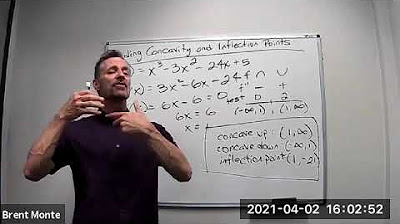Maxima , minima and point of inflection
TLDRThis instructional video focuses on determining the points of maximum and minimum values, as well as the point of inflection for the function y = x^3 - 12x^2 + 36x + 8. The process begins by finding the first derivative and setting it to zero to locate points where the slope is zero. The quadratic equation 3x^2 - 24x + 36 = 0 is solved to find x = 2 and x = 6. The second derivative test is then applied to these points to determine if they correspond to a maximum or minimum. The second derivative, 6x - 24, is evaluated at x = 2 and x = 6, revealing x = 2 as a maximum and x = 6 as a minimum. Finally, the point of inflection is found by setting the second derivative to zero, resulting in x = 4, where the curve changes concavity. The video concludes with a clear explanation and a visual representation of the function's behavior.
Takeaways
- 📚 The video's objective is to teach how to find the points of maximum and minimum, as well as the point of inflection for a given function.
- 🔍 The function provided for analysis is y = x^3 - 12x^2 + 36x + 8.
- 📝 To find the maximum and minimum points, the first step is to calculate the first derivative of the function and set it equal to zero.
- 🔢 The first derivative of the function is found to be 3x^2 - 24x + 36.
- 🧩 By simplifying the first derivative equation, we get x^2 - 8x + 12 = 0, which is a quadratic equation.
- 🔍 The quadratic equation is factored to find the critical points: x = 2 and x = 6.
- 📉 To determine if these points are maximum or minimum, the second derivative test is used.
- 📈 The second derivative of the function is calculated as 6x - 24.
- 📊 Plugging x = 6 into the second derivative gives a positive result, indicating a minimum point.
- 📈 Plugging x = 2 into the second derivative gives a negative result, indicating a maximum point.
- 🔄 The point of inflection is found by setting the second derivative equal to zero, resulting in x = 4.
- 📚 The point of inflection is where the curve changes concavity, from concave to convex or vice versa.
Q & A
What is the given function in the video script?
-The given function in the video script is y = x^3 - 12x^2 + 36x + 8.
What are the main points we need to find for the given function?
-The main points we need to find for the given function are the points of maximum and minimum, and the point of inflection.
What is the first step in finding the maximum and minimum points of a function?
-The first step in finding the maximum and minimum points of a function is to find the first derivative of the function and set it equal to zero.
What is the first derivative of the given function?
-The first derivative of the given function y = x^3 - 12x^2 + 36x + 8 is dy/dx = 3x^2 - 24x + 36.
How can we simplify the equation 3x^2 - 24x + 36 = 0?
-We can simplify the equation 3x^2 - 24x + 36 = 0 by dividing both sides by 3, resulting in x^2 - 8x + 12 = 0.
What method is used to solve the quadratic equation x^2 - 8x + 12 = 0?
-The method used to solve the quadratic equation x^2 - 8x + 12 = 0 is factoring, which gives us (x - 6)(x - 2) = 0.
What are the critical points found from the first derivative?
-The critical points found from the first derivative are x = 6 and x = 2, where the slope of the function is zero.
What is the purpose of finding the second derivative of a function?
-The purpose of finding the second derivative of a function is to determine whether a critical point is a maximum, minimum, or neither by checking the concavity of the function at that point.
What is the second derivative of the given function?
-The second derivative of the given function is d²y/dx² = 6x - 24.
How can we determine if a critical point is a maximum or minimum using the second derivative?
-If the second derivative at a critical point is positive, the point is a minimum. If it is negative, the point is a maximum.
What is the point of inflection and how is it found?
-The point of inflection is the point where the function changes its concavity from concave to convex or vice versa. It is found by setting the second derivative equal to zero and solving for x.
What is the x-coordinate of the point of inflection for the given function?
-The x-coordinate of the point of inflection for the given function is x = 4, found by setting the second derivative 6x - 24 equal to zero.
How does the second derivative indicate the concavity of the function at a point?
-If the second derivative at a point is positive, the function is concave up (minimum slope) at that point. If it is negative, the function is concave down (maximum slope).
Outlines
📚 Introduction to Finding Extreme Points and Inflection Points
This paragraph introduces the problem-solving process for a given function, y = x^3 - 12x^2 + 36x + 8, with the aim of finding its maximum and minimum points as well as the point of inflection. The first step outlined is to find the first derivative of the function, set it equal to zero, and solve for x to find critical points where the slope is zero. The process involves calculating the derivative, simplifying the equation to a quadratic form, and solving for x to get potential x-values for the extremities.
🔍 Analyzing Critical Points with First and Second Derivatives
This paragraph delves into the method of determining whether the critical points found (x = 2 and x = 6) correspond to maximum, minimum, or neither by using the first and second derivative tests. The first derivative is used to locate points where the slope is zero, while the second derivative helps to identify the nature of these points. By substituting x = 6 and x = 2 into the second derivative, 6x - 24, the sign of the result indicates whether the function has a minimum (positive second derivative) or maximum (negative second derivative) at those points. It is concluded that x = 6 is a minimum and x = 2 is a maximum.
🔄 Identifying the Point of Inflection
The final paragraph explains the concept of the point of inflection, which is where the curve changes its concavity. To find this point, the second derivative of the function, previously calculated as 6x - 24, is set to zero and solved for x, yielding x = 4. This x-value corresponds to the point where the function transitions from concave to convex. The explanation emphasizes that at the point of inflection, the second derivative is zero, indicating a change in the curve's shape.
Mindmap
Keywords
💡Maximum and Minimum Points
💡First Derivative
💡Second Derivative
💡Inflection Point
💡Quadratic Function
💡Critical Points
💡Slope
💡Concavity
💡Factoring
💡Graph of a Function
Highlights
The video aims to solve a problem on finding maximum and minimum points and the point of inflection for the function y = x^3 - 12x^2 + 36x + 8.
The first step is to find the first derivative of the given function to locate the maximum and minimum points.
The derivative of the function is calculated as 3x^2 - 24x + 36.
The derivative is simplified to x^2 - 8x + 12 by dividing all terms by 3.
The quadratic equation x^2 - 8x + 12 is set to zero to find critical points.
The quadratic is factored into (x - 6)(x - 2) to find x = 6 and x = 2 as potential maximum/minimum points.
A graph is drawn to visualize the function and its critical points.
The second derivative test is introduced to determine whether the critical points are maximum or minimum.
The second derivative of the function is calculated as 6x - 24.
Evaluating the second derivative at x = 6 shows a positive value, indicating a minimum point.
At x = 2, the second derivative is negative, signifying a maximum point.
The function reaches its maximum at x = 2 and minimum at x = 6.
The concept of the point of inflection is introduced as a point where the curve changes concavity.
The second derivative is set to zero to find the point of inflection, resulting in 6x - 24 = 0.
Solving for x gives x = 4 as the point of inflection.
The point of inflection is where the curve changes from concave to convex at x = 4.
The video concludes by summarizing the use of first and second derivatives to find maximum/minimum points and points of inflection.
Transcripts
Browse More Related Video

Finding Concavity and Inflection Points

Analyzing a function with its derivative | AP Calculus AB | Khan Academy

Fiding Relative Max, Min and Inflection Point with Derivatives F4

Calculus I: Finding Intervals of Concavity and Inflection point

Absolute Maximum and Minimum Values - Finding absolute MAX & MIN of Functions - Calculus

Second Derivative Test to find relative maximums and minimums (extrema)
5.0 / 5 (0 votes)
Thanks for rating: